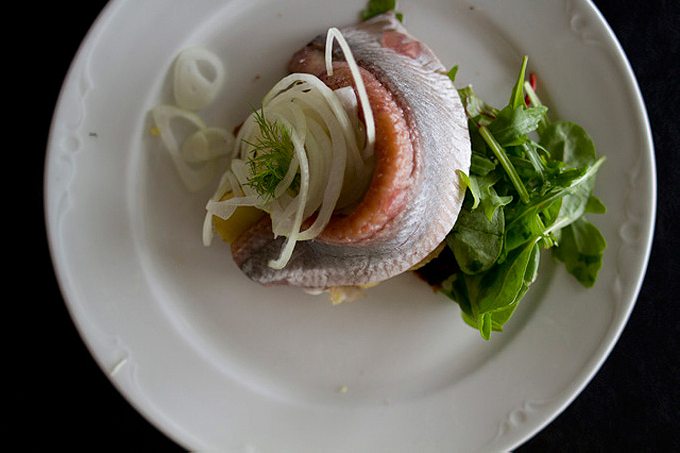Denmark’s open-face sandwich is an evolutionary key, something between entrée and sandwich, a fish that walks on flippers.
If there is such a thing as a northern European food craving, for me it’s this: an open-faced sandwich topped with herring or lox, or, in a pinch, a coldcut or cheese. The Germans call these belegtes brötchen—laid-on bread. The Danes, just up the coast, call it smørrebrød.
I don’t speak Danish, so I can’t really tell you how to pronounce smørrebrød, but I think if you let out a flat American “er” (like at the end of “butter”) while flapping your lips slowly, you’ll get close.
I also can’t say exactly why the northerners have taken to this dish, but I do know that the closer toward the Baltic Sea you travel, the quicker the wind and the more lateral the sunlight, the more and more you’ll see these open-faced sandwiches. And when you finally reach the water’s edge, whether in Mecklenburg in Germany or Zeeland in Denmark, where we’ve been this week, this plate is everywhere.
At the Utzon Café, a sleek harborfront restaurant overlooking the Limfjord in Aalborg, near the very northern edge of Europe, Matt and I ordered two of these each, only to find something much more, well, vertical than we expected. My pickled herring smørrebrød had a supple flank of the fish folded high over itself, tall enough that a top piece of bread, had there been any in sight, would have just fallen over anyway. Still the flavors sat just right: a slight vinegar to the fish, a bite from the onion, the dark rye underneath to give it earth.
This smørrebrød was ambitious. It needed a knife and fork. The toppings completely covered the bread underneath, so the dish looked more like an entrée than a sandwich. This is my idea about Smørrebrød: it’s an evolutionary key, something between entrée and sandwich, a fish that walks on flippers.

The wind has been incredible this week. In rural Jutland, it attacked directly over the plain. In Copenhagen, it hid in the narrows of Christianshavn and ambushed me every time I turned a corner: an unexpected rush of air, often carrying cold, sideways rain. On the massive bridges that the Danes use to cross their straits and fjords, the wind tried to kill me and Matt, waiting until just the right moment and then hitting our car from the side with so much force that it took two hands and a strong grip just to stay in our lane. The wind had hoped that I would overcorrect and crash over the rail or headlong into oncoming traffic. I know this evil intent of the wind. It is an agent of chaos, it wants to scour and uproot, to push against the bodies of men and beast in Denmark, to knock trees down, to shove water over the pebbled shore and flood the streets. That is what I think of the wind after a week in Denmark. It is Loki, Changuïto, it is a trickster god with ill intent.

So of course when I look at these smørrebrød, and contemplate its evolution here, I imagine a century of Danes carefully making sandwiches, and then just at the moment that they sit to eat, the wind pushes open a window, gusts through the room and knocks the top slice of bread off. Repeat that a few thousand times throughout the Kingdom, and after a while the Danes will simply stop adding top bread. Smørrebrød, born.
Credit the Danes for turning this persecution into an opportunity: freed of a ceiling, smørrebrød is unbound, ready to improvise. Matt’s first smørrebrød had roast pork laced with tiny curls of pork crackling, pickled cabbage and thick slices of dill pickle. He followed that up with fried whitefish, remoulade and cherry tomatoes. Both piled high, both requiring careful cutlery work. I went classic with the herring, but after that, my single slice of rye was paved with thick tiles of Danish blue cheese, plus rounds of red onion and a tuft of spring greens, all topped with a raw egg yolk that comes in a ramekin on the side.
Our smørrebrød was heavy, weighted, significant. Wind, do your worst.